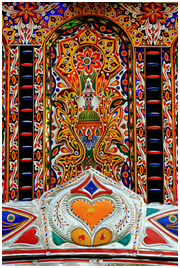In the decades that followed the nation’s independence, Pakistani artists adopted modernism as a metaphor for change and economic freedom. The art world, and Pakistan itself, was evolving – no longer hindered by stereotypes.There would be challenges of transition, but Pakistan continued to educate and enrich itself.
Pakistani artists wanted to present themselves as modern according to international standards, and adopted styles popular in the United States and Europe but they also began experimenting with native traditions to see how these could be adapted. Modern art was chosen as the country’s visual language because typical traditional art seemed to be inadequate to properly express the dreams and fears of a generation aiming towards a new era of freedom.
The 1960s brought a strong American cultural impact on Pakistani urban centers. Films and publications were shown, and media was used to promote Abstract Expressionism – the United States’ first art movement. Through art historians and visiting exhibitions, Pakistani artists received exposure to abstract style. Those educated in the English medium schools readily adopted western styles, valuing forward progress.
“Truck art” – LAHORE
The first artist in Pakistan to actually have an exhibition of modern paintings was a woman. Zubeida Agha developed an approach to painting that reflected her education and experience in both Pakistan and Europe. Today, Pakistan has an unusually high ratio of female artists due to the fact that the art industry has not traditionally been viewed as a lucrative business by men. In the past, creatively-inclined men in Pakistan have focused more on fields of advertising or illustration, leaving the art field open to women. Modern Pakistani female artists continue to impress not only their country, but the entire world.
Pakistan is a country rich and diverse in all forms of art and culture. The country is home to numerous art galleries, museums, performing arts theaters, drama and dance studios, and film events. Although Lahore is depicted as the cultural capital, all major centers – and many rural areas – have cultural events and festivals throughout the year.
Humera Usman Sheikh

Whatt-ayy level
ReplyDeleteHumera bht achaw likhaw hai
ReplyDeleteaww humera sheedo loves it<3
ReplyDelete